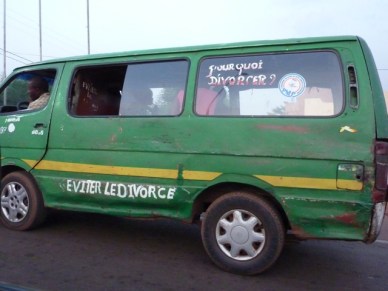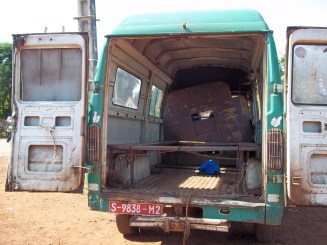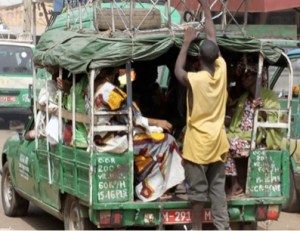For getting around Bamako, you really have four options.
- Provide your own transportation. As I wrote in a previous post, more and more Bamakois can afford to do so, whether on two or four wheels. Still, most city residents don’t own cars or motorcycles.
- Take a taxicab. While cabs in Bamako may be battered, they are plentiful and, by the standards of any developed country, quite cheap. A 30-minute ride across town might cost 2000 francs if you don’t bargain much; that’s around US$4.00. 2000 francs being equal to many households’ daily budgets, however, cabs are still too pricey for most Bamakois to use very often.
- Hop on a bus. Buses in Mali are generally used for transport between cities rather than within them, but some buses do operate on a handful of fixed routes around Bamako. Since these routes only serve a few neighborhoods, most Bamakois have never ridden in one. Why not, therefore…
- Ride a SOTRAMA — this is the Bamako term for a van modified and licensed to carry paying passengers along a fixed route. And riding a SOTRAMA is an experience unto itself.
First a bit of background: the name “SOTRAMA” comes from the era when all these vehicles were run by a state company, La Société du Transport du Mali. For years now, though, they’ve all been in private hands: each SOTRAMA van belongs to somebody, who usually hires a driver from whom he/she receives a flat daily fee. Typically the driver must pay 15,000 francs (US$30) to the owner per day, plus an equivalent amount for diesel fuel. Maintenance costs are incumbent on the owner, but given the state of most of these vans, it’s clear they don’t receive much maintenance. A van is purchased used in Europe and brought to Mali, where the interior is stripped to bare metal, and some spartan wooden benches are bolted in place so as to allow any passenger to enter or exit through the side door without other passengers having to move.
SOTRAMAs are uncomfortable and slow. They don’t run on predictable schedules, and you can only learn where one goes by asking someone who knows. But they do have the advantage of being cheap. The most expensive SOTRAMA fare I know in Bamako is 225 francs, about US$0.45, while the typical fare ranges from 125 to 150 francs. (These fares rise along with the price of diesel, which is fixed by the Malian government these days at 605F/liter, around US$4.50 per gallon at the current exchange rate. Gasoline costs 14% more.)
SOTRAMAs are a highly social means of transportation, by necessity: climbing aboard, you find yourself in close proximity to 20 other passengers, in a vehicle that might carry half that many in any wealthy country. Over the years I have learned some tips for quality SOTRAMA riding.
- Make sure it’s going where you’re going. SOTRAMA routes are never published, and are frequently changed. Moreover, some neighborhoods are served by multiple routes which may have similar names (e.g. “Magnambougou” vs. “Magnambougou Projet”; “Nafaji” vs. “Nafaji Féré”). When taking a route for the first time, always ask the driver or a fellow passenger if it will get you where you want to go.
- Say hello. Each passenger greets fellow passengers immediately upon boarding. As in most Bamako milieus, Bambara-language greetings are best; “A ni tché” works as a blanket greeting at any time of day.
- Watch your head. There’s precious little headroom in SOTRAMAs, particularly in the Toyota HiAce vans which are the most common model on many routes. Remember that the owners install overhead handrails; make sure not to bump into them. (In the headroom department, I much prefer my SOTRAMA to be in the Mercedes Benz MB100 series, like a 207D or 307D; I also appreciate a 312D. But the SOTRAMA passenger can rarely afford to discriminate.)
- Don’t carry your fare in your trouser pockets. Once you squeeze into whatever gap is left on the bench, you most likely won’t be able to get to anything in those pockets until you stand up again. Shirt pockets are useful in this circumstance.
- Exact change is appreciated. At some point you must pay your fare to the “prentikè,” a surly young dude riding by the side door. He may or may not be able to give you change — there are never enough coins in this town — so it’s advisable to pay as close to the exact fare as you can. If you have extra money, you can always pay the fare of a fellow passenger, e.g. a handicapped or elderly person. (Such individuals in Bamako are seen as inherently deserving of charity. Do not attempt to pay for a young, healthy passenger you don’t know!) Such an act of random kindness costs very little but can generate more goodwill than a million dollars of bilateral development assistance.
- Don’t take the prentikè personally. Along with rustling up passengers (by shouting the SOTRAMA’s destination in an incessant slur of vowels) and collecting fares, rudeness is part the prentikè‘s job description. There are two other things you can expect from a prentikè anywhere in Africa. One, he will carry any paper currency he receives wadded up between his fingers. Two, he will only enter and exit the vehicle while it is in motion. These are part of his déontologie professionnelle; I suspect he receives job training in the various ways to diss passengers, wad up banknotes and leap from moving vehicles without losing his flip-flops. Bamakois realize that the prentikè‘s life is not an easy one, so they try not to be too harsh with him. (To learn more about the world of the prentikè, see this recent French-language “day in the life story” about a SOTRAMA prenti, including some of the prenti‘s unique jargon, from a Bamako newspaper.)
- Signal your stop. The driver only pulls over his SOTRAMA when he knows someone wants to get on or off. Shortly before reaching her destination, a passenger must tell the prentikè; the prentikè then relays the message to the driver by banging loudly on the vehicle’s roof or side panels. (While passengers may be tempted to eliminate the middleman by rapping on the vehicle themselves, I advise against this; the prentikè sees it as an encroachment on his privileges.) After you’ve signaled your stop and the van pulls over, say goodbye (“k’an bè“), and remember to watch your head while disembarking.
 One of the singular aspects of the SOTRAMA as social space is the degree of familiarity that obtains between complete strangers riding in it. A mother with a babe in arms may hand off her young charge to a passenger she’d never met before while stowing her bags beneath her feet. There is no segregation of the sexes: a male passenger may be wedged in tight next to a woman in a full-face veil. I’ve never seen anyone object.
One of the singular aspects of the SOTRAMA as social space is the degree of familiarity that obtains between complete strangers riding in it. A mother with a babe in arms may hand off her young charge to a passenger she’d never met before while stowing her bags beneath her feet. There is no segregation of the sexes: a male passenger may be wedged in tight next to a woman in a full-face veil. I’ve never seen anyone object.
A final note: Bamako has long been home another interesting public transportation option, the bâché. This is a pickup truck with benches in the back, covered by a heavy tarp (la bâche, hence the vehicle is bâché). One can still ride them, but they’re limited to a couple of routes where they used to be all over town (see below).
POSTSCRIPT (May 2019): See Coleman Donaldson’s street interviews about Bamako’s Sotramas.




“Along with rustling up passengers (by shouting the SOTRAMA’s destination in an incessant slur of vowels) and collecting fares, rudeness is part the prentikè‘s job description.” lol!! You blog is just what i needed for a good laugh!! Those preteke’s are so RUDE!
Pingback: Brief update for Thursday, April 5 | Bridges from Bamako
Pingback: What’s to love about Mali? Four things. | Bridges from Bamako
Pingback: The Advocacy Project | Ramadan in Bamako
Pingback: Writing the Afropolis | Bridges from Bamako
Pingback: What a day! – Lighthouse International School, Bamako
Pingback: What a day! – Lighthouse International School, Bamako
Pingback: The Corona Chronicles, Bamako | Bram Posthumus - Yoff Tales
In the good old days they had sotramaesque vans in São Paulo too, known as peruas. (In Rio they were known as Bestas, from the type of vehicle normally used). I remember the drivers shouting out the destinations, just as mentioned here. Then the Government clamped down on vans, only one line still survives near Lapa Market but the charm has been lost. (The Government also axed hundreds of bus lines too, and now transport in SP is terrible – the metro is good though) Thank goodness for Uber which serves the city well.
You may be interested in why a British man in Brazil is interested in Mali. The fact is that Malian music is great! The country looks interesting too. A sotrama ride would not be unusual for me as I have been in ‘peruas’ many times here.